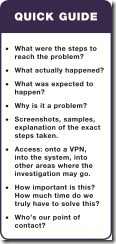Help Me Help You: The Must-Haves Behind Project Development
You may have had a few conversations that resemble the following:
"Tech Support, how can I help you?"
"Nothing is working!"
"Could you please clarify? What isn't working?"
"I mean, NOTHING is working! I need this fixed immediately!"
Improvements in technology are incredible. But one small issue with the ease of technology is a slight disconnect we may encounter when trying to solve problems for our clients… who are hundreds or even thousands of miles away.
So the first step in fixing their problem materializes as a question — or quite a few. Where do we go from here? How exactly is this project going to develop? What information do we need to efficiently solve this? Will it be a serene, fairytale where all information, discovery and solutions fall quickly and quietly into place?
Of course not! Sometimes it's a mixture of quiet frustration building to hair pulling, coffee breaks, and multiple emails. And Skypes. And phone calls. And… well, you get the idea.
But this can be remedied! Hopefully.
By detailing what you need from your client and helping mold them into delivering that information the first time around, you can save yourself some time and your client some cash.
Details, Details, Details…
This is the one time when way too much information to sort through is the best gift. We can't help solve the problem if we don't know why it's broken. And as much as we know about business, we have to admit we're just not as good as the client — they know their business better than we do.
Which is why, first, we have to understand just how important the issue is to their business. If we have 10 minutes, the going will be tough. If we have until month end rolls around again, we can take a deeper breath. This helps us determine how much time we will need to put into the problem, and how quickly we must address it.
Once importance has been determined, the rest of the details come into play. Because we aren't near the client, they can't physically step us through their process. So, we have to ask the pertinent questions and hope for detailed answers. What is the problem? What exactly went "wrong?" Again, the client knows their business best, and they need to be the ones to explain why the issue was an issue, specifically. No matter how adept we are at testing our solutions, the client is the only one who truly understands how they use the programs. What did they expect to happen?
A Picture is Worth a Thousand Words
Sometimes, the easiest way to understand a problem is to see the problem — again, slightly troublesome when we are available only across a small wire. If available, the easiest antidote is a shot of the screen itself. At the least, a breakdown of the steps taken to achieve the undesired problem should be sent. When we can follow their steps to the "T" we can hopefully recreate the problem and discover a solution.
But we can't know what to solve if we don't know how to get there.
Access? You Don't Need Access!
What's the best problem of living across a wire? Discovering where the point of entry for that wire exists on the other end. A few minutes connecting followed by a half hour of problem solving, or a few days attempting to gain access with no problems solved. Which would you rather pay for? It is surprisingly difficult gaining access to some systems. There are a plethora of VPNs and access points we have to navigate, combined with the necessary credentials within the system itself. Having the correct credentials and a fairly stable VPN helps exponentially.
After connecting, we need to determine who we need to contact regarding this issue. Are we allowed to talk directly to the employee? Is there a chain of command that has to be followed? There's nothing worse than awkwardly e-mailing the wrong person with information they don't need to know or don't know what to do with.
The Solution…
…is potentially reached by following these steps. It's at least reached much more efficiently with more information up front. We need to encourage our clients to follow a set of guidelines that help us reach the problem, and subsequently the solution, quickly.


